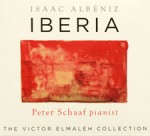Column Name
Title
lbéniz: Iberia. Peter Schaaf, piano. (The Victor Elmaleh Collection, VEC 101)
Body
This unusual recording carries a compelling story: during his study with the renowned Juilliard pedagogues Sasha Gorodnitzki and Rosina Lhévinne, Peter Schaaf (B.M. ’64, M.S. ’65, piano) discovered the sensuality—and monumental difficulty—of Isaac Albéniz’s Iberia. Schaaf received accolades for his pianistic abilities (for example, the Kosciuszko Foundation’s 1961 Chopin Prize) and enjoyed some success as a soloist and in chamber music circles. But as time passed, he moved away from music and explored his talent for photography—which is, as he jokes in the liner notes, “much easier than piano—it only takes one finger.” He has developed his visual strength into a career teeming with photographs of some of the most famous musicians on the planet: Vladimir Ashkenazy, Elly Ameling, Isaac Stern, and Seiji Ozawa, among others. (Observant Juilliard Journal readers are likely to be familiar with Schaaf’s photo credit, which often appears in this paper.)
In 2008 Juilliard faculty member David Dubal heard that Schaaf once was an active—and fine—pianist, and asked him if he would play for his popular Evening Division class, the World of the Piano. After an initial “no,” Schaaf changed his mind, and the eventual result was this recording, produced by Concert Artists Guild as part of an initiative featuring artists early in their careers, and sponsored by Victor Elmaleh, an architect and real estate developer. Schaaf also enlisted Ryan Streber (Pre-College ’97; B.M. ’01, M.M. ’03, composition) to do the sound engineering (at Oktaven Audio in Yonkers).
The 12 sections of Iberia are among the most fearsome in the repertoire, and Schaaf acquits himself with distinction. In this immensely challenging panorama of Spanish scenes, he finds poetry and shows that Albéniz’s quiet moments can pack the same kind of wallop as those which set the keyboard ablaze. From the opening, a moving account of “Evocación,” he shows unflagging energy and empathy for the score. “Málaga” has plenty of atmosphere—one can almost smell the Mediterranean sea air—and Schaaf’s glittering account of “Jerez” (the birthplace of sherry) might have some reaching for a glass to toast his success. Here and there—as in “Lavapiés,” which Albéniz himself thought might be unplayable—the strain of the composer’s demands is evident, but overall, Schaaf’s facility and affinity for the composer’s colors and evocative rhythms will make many sit up and take notice. Hear the results for yourself (and see his photographs) at peterschaaf.com.
Pater Seraphicus: David Enlow Plays César Franck. David Enlow, organ. (Pro Organo CD 7247)
For his first recording, Juilliard faculty member David Enlow (B.M. ’03, M.M. ’05, organ) offers a generous selection (on three discs) of César Franck’s output for the instrument. (Only a few early works and the selections that were called L’Organiste—which were originally for the harmonium— are excluded.) Enlow’s program, recorded on the same magnificent organ at the Church of St. Mary the Virgin Times Square that Juilliard organ department chairman (and Enlow’s teacher) Paul Jacobs used for his Grammy Award-winning Messiaen recording, is titled Pater Seraphicus, the affectionate nickname Franck’s students gave him. It is arranged chronologically, with the Fantaisie in C, Op. 16 (the first of Six Pièces, Op. 16-21, published in 1868) as a reverent opener. The Grande Pièce Symphonique follows, which Enlow describes in his liner notes as “a height of achievement not to be underestimated.” Its dense, radiant spectrum of timbres shows Enlow’s masterful command of the Aeolian-Skinner instrument’s enormous range, particularly its arresting lower register. Other highlights include the Pièce Héroïque, with its magnificent conclusion, and Franck’s final composition, the third Choral (in A minor), with its labyrinthine path leading to a thundering evocation of the afterlife. Throughout, the combination of Enlow’s mastery and the church’s resonance should make Franck admirers very happy.
As a bonus, the set includes a nine-minute video download about the project, with close-ups of Enlow’s hands and feet at work. He comments on the difficulties in interpreting these pieces freshly while remaining true to the composer’s intent, and takes note of the marvelous acoustics of the church, a destination for organ aficionados everywhere. Frederick Hohman is the sound engineer, and he also provided the post-production, mastering, and contributed the booklet photographs. The slightly distant miking seems wholly appropriate to capture the huge sound stage. Enlow also wrote the erudite notes, and in them he chides organists who have turned these works into “showpieces for bad taste and poor technique, devoid of nuance and tenderness.” Happily, however, the introspection and sensitivity he seeks are evident in every bar.






